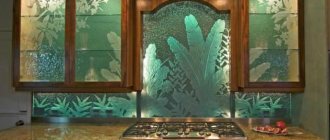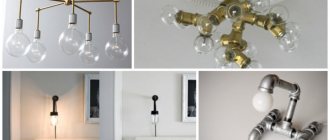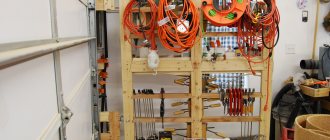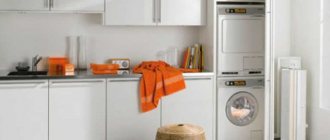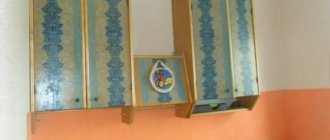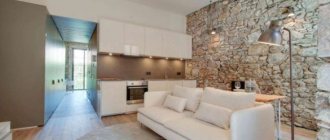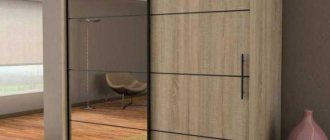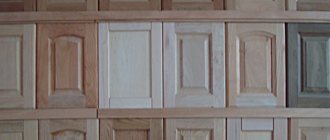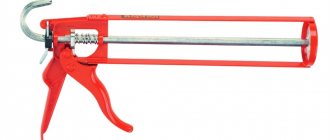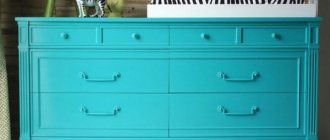Why do you need lighting in a closet?
Sliding wardrobes do not have hinged doors that block narrow passages and steal precious space. It is not surprising that they are often placed in places with limited space and insufficient lighting. Additional lighting is also needed when the cabinet is deep, where the light from the ceiling lamp simply does not reach.
A convenient and modern solution is to use lighting in the cabinet itself.
Or maybe you don’t want to turn on the lamp again so as not to wake up sleeping family members. Or do you need additional lighting in the mirror area, where there are always not enough lumens. Or the main reason is not functional, but aesthetic. LED strips and built-in lamps visually transform furniture and change the perception of the interior of the entire room.
In developed countries, furniture without lamps is no longer produced.
To understand whether backlighting is needed or not, it’s worth deciding on the functions it can perform:
- Additional illumination of individual areas with insufficient lighting.
- Decorative.
- The ability to illuminate the storage system without turning on the main light sources.
Features and advantages of cabinet lighting with LED strip
Lighting the interior space of the furniture will diversify and refresh the interior of the room. LED cabinet lighting is used not only as a decorative device, but also has a practical function. Often, the storage module occupies the darkest place in the room, so in the morning and evening hours the contents of the shelves are not visible; to access things you need to turn on the light in the room. A strip with LEDs will make it easy to find the necessary item on the illuminated shelves even in the dark.
In terms of performance, LED backlighting prevails over its halogen counterparts. Key advantages include a longer operating life and lower energy consumption.
The advantages of LEDs are also:
- compact dimensions;
- low operating voltage;
- impact resistance;
- vibration resistance;
- possibility of adjusting the brightness of the light flux;
- environmental Safety;
- fire safety.
Choosing wardrobe lighting
Classic incandescent lamps with spiral coils are practically no longer used in furniture lighting. Main types of lighting: halogen, fluorescent, LED. The latter are in the form of spotlights or LED strips.
More and more furniture factories and private workshops are supplying cabinets with lighting included.
Types of lighting
Cabinet lighting, main types of lighting:
- Luminescent.
- Halogen.
- LED, including LED strips.
Cabinet lighting performs two functions at once: practical and decorative.
How to choose the right one
As when choosing any other product, you should first evaluate its health safety. Fluorescent and energy-saving lamps can pose a real, and more often potential, threat to the body. The former contain a small amount of mercury, which theoretically can lead to poisoning, including small doses of vapor if the seal of the product is broken. However, the concentration of the harmful substance is so low that the threat should not be taken seriously.
Illuminated products have significant advantages.
Prolonged exposure to ultraviolet radiation from fluorescent sources is also unsafe. However, for a cabinet where the need for lighting occurs for a short time, this threat is also not relevant. The German endocrinologist Wunsch, in an interview with Neu Osnabrücker Zeitung, argued that the stroboscopic effect of fluorescent lighting at a frequency of 50 Hz can lead to epilepsy. However, over the next ten years, the scientist’s assumption was not confirmed by anything.
Lighting elements allow you to diversify the design of furniture and make the interior of the room interesting and unique.
When choosing, you should take into account the interior style, room features, existing lighting and lamp characteristics:
- brightness;
- power;
- energy saving features;
- color and design features of the lamp.
Power supplies. Rechargeable batteries and batteries need to be periodically charged and replaced. USB-powered LED lights are usually not practical for cabinet or other furniture lighting. Light sources that connect to household power may require an additional outlet.
Lighting the filling and contents of the closet allows you to quickly find the things you need in it.
Please note that ready-made lighting kits are available for sale. Including automatic ones, with motion sensors, and those triggered by opening the cabinet door.
The lighting can be mounted in any type of cabinet.
Important! The use of a carrier is highly undesirable. If the power is supplied not directly from the network, but through a 12 or 24 V transformer, the converter should not be located near heaters or open flames.
And the last aspect is the integrity of the cabinet walls and doors. If you have to saw and cut furniture to install the lighting, problems will certainly arise when you subsequently replace the lamps. It is highly likely that you will have to mask the holes... or buy a new wardrobe.
The modern furniture market offers a variety of types of cabinet lighting.
Types of lighting, pros and cons of options
First you need to decide on the type of backlight. The following options are possible:
- halogen;
- luminescent;
- LED
It must be taken into account that the devices will operate in tight spaces and in close proximity to the contents of the cabinet. You can use any type of lighting to illuminate a cabinet, but first you need to understand the features of each type. Let's look at them in order.
Halogen
This is a backlight that is a modified incandescent lamp. Bromine or iodine vapor is pumped into the flask, which makes the heating of the coil much higher and the glow brighter. The advantages of halogen lamps are:
- increased brightness that does not change throughout the entire service life;
- small sizes;
- safety of lamps.
Disadvantages should be considered:
- high heating of the flask;
- low strength;
- Do not touch the flask with your hands;
- sensitivity to voltage changes;
- limited service life.
The disadvantages of halogen lamps are quite significant, so their use for interior lighting is undesirable.
Luminescent
Using fluorescent lamps as lighting is a better option. They have a lot of advantages:
- no strong heating;
- significant light output;
- long service life;
- wide choice of colors.
The disadvantages are:
- quite large size;
- complex connection procedure;
- sensitivity to temperature.
Interesting! In addition, there are harmful mercury vapors inside the fluorescent lamp bulb. If, while searching for the right things, the fragile glass case is accidentally damaged, there is a danger of poisoning. This feature, combined with the large size, limits the use of fluorescent lamps for illuminating the wardrobe.
LED lights
LEDs have been used as a lighting option relatively recently, but are already confidently replacing alternative types of lamps. The reason for this is the significant advantages:
- no heating;
- low-voltage power supply, making the lighting safe for people;
- wide choice of color shade, brightness and type of devices;
- there are multi-colored elements capable of creating attractive decorative effects;
- long service life of LEDs.
DIY installation
How to make additional lighting in a closet with your own hands? The easiest way to install LED strips. It is not surprising that more than 90% of owners of apartments and private houses prefer to use this type of lighting for illuminating cabinets and other furniture.
LED lighting combines several advantages: efficiency, durability, safety and high quality lighting.
There are other advantages:
- energy saving parameters (consume energy 10 times less than classic incandescent lamps and 2 times less than fluorescent sources);
- safety (“classic” ones break easily, leaving sharp fragments; luminescent ones contain mercury vapor, albeit in small quantities);
- “lifetime” (mean time between failures reaches 50 thousand hours, fluorescent lamps – up to 7 thousand, incandescent lamps – up to 2 thousand).
- maximum approach to natural light.
Unlike halogen and fluorescent lamps, LEDs do not tend to get very hot.
Connection method
Most often, lighting devices are connected either directly to a household power supply, or through a 12 or 24 Volt power supply. The converter may have to be purchased separately. When planning lighting, it is worth considering the proximity of sockets so that you do not have to make wiring at the last moment.
LED strip is sold in skeins of 5 meters or by meter. It is recommended to take accurate measurements before purchasing a backlight.
Installation sequence
Let's consider the stages of installing LED strip, the most popular option for cabinet lighting.
- Determine the location of the tape. When attaching to shelves, it is recommended to mount the tapes on the bottom side. The likelihood of mechanical damage is reduced. Better lighting for the bottom shelf.
- Decide on the location of the switch (bottom of the shelf, side panel of the compartment, wall near or behind the cabinet).
- Take measurements. Cut the tape (only in specially designated places!).
- The tape is installed either by laying it in a plastic box or in a cable channel attached with liquid nails. Self-adhesive tape is also sold. In this case, it is easiest to mount.
- Install switches in predetermined locations, connect the strip to a power source, and check the operation of the newly installed backlight.
The process of installing cabinet lighting requires care. It is advisable to think through its scheme in advance.
Installation work
Not everyone knows how to make LED lighting with their own hands, so they believe that this is labor-intensive and expensive work. In fact, the installation is not complicated, but it is necessary to take into account some points that will prevent problems from arising during further operation. It is enough to have basic knowledge of electrical installation work. The whole process is carried out in a certain sequence and consists of several stages:
- You need to purchase a tape of the required length with diodes, special connectors for fastening, a conductive cable, a reliable power supply (if it is not included), double-sided tape for construction work, and connecting clips.
- Tools: sharp utility knife (sold in hardware stores).
- The preparatory work includes inspecting the tape, which should not be flawed or damaged. Examine the markings of the power supply and tape (they should be similar to each other).
- Then the contact elements are found. As a rule, they are located through 3 diodes. This corresponds to Russian and Chinese manufacturers. It is important to proceed from the structural features of the material that you purchased, since the cut is made in this exact place. This is significant, since an incorrect cut entails waste of material.
- The LED strip is cut into the required pieces. Insulating material 1-1.5 cm long is removed from the electrical cable (this is necessary for connection). Usually the wires are color-coded: white, brown, or optionally red or yellow. The first one is for “minus”, and the second one is for “plus”. In any case, it is necessary to avoid contact between the wires. For this purpose, special insulating tape is used. Clarification: first of all, individual contacts are isolated, and only after that the entire blocks.
- Then the prepared wires are connected to the connector. In this case, the brown (yellow or red) wire is inserted inside, and the white wire is inserted on top.
- Final stage: checking how the lighting works. Everything is quite simple: the power supply is connected to the network. If everything is done correctly, the tape will light up.
- This completes the electrical work, and all that remains is to secure the tape in the chosen location. To do this, the table surface, ceiling or wall are degreased and dust is removed from them. You must use any neutral detergent to avoid damage to the surface or finishing material.
- Remove the protective film from the adhesive side of the tape, or use double-sided adhesive tape, which is attached to the selected location. The organization of LED strip illumination is completed.
Electrician's recommendation. Specialists who know how to solder various parts, have the tools and skills, can do without connecting clips, while the connection will comply with the LED backlight installation technology.
A detailed description of how to make furniture lighting helps you do it yourself, while increasing the functionality and safety of the premises. The interior acquires a unique decoration; it is possible to change the color scheme of the rooms depending on your own preferences.
Wardrobe light when door opens
You can make a lighting system that triggers when the cabinet door opens yourself. However, it is easier to buy a ready-made kit with motion sensors. Lighting in the closet when the door is opened is a fairly convenient lighting option. You won’t have to look for the switch in the semi-darkness again.
If bright lighting is required, it is advisable to use overhead lamps - they are more powerful than recessed ones.
Furniture lighting for the kitchen, kitchen furniture
For the kitchen, it is better to choose lamps with a white neutral glow; it will not distort the color of food or food during preparation and irritate. I recommend paying attention to touch-sensitive lamps and models equipped with a motion sensor. It is very convenient if the lighting for kitchen furniture turns on with a simple wave of the hand, without touching it - which means you can not be distracted from cooking and wash your hands if, for example, while kneading dough or cleaning fish, you suddenly discover that there is not enough light in the kitchen.
If you can’t find a suitable overhead lamp with touch or infrared control or you’re not happy with the cost, you can make it yourself: insert an LED strip into an aluminum profile and add a dimmable touch or infrared switch to the circuit that responds to movement or obstacles.
The lighting of furniture in the kitchen is interesting, including the inside of cabinets and cabinets as follows:
- With magnetic sensor. When the cabinet door is opened and the magnet is removed more than 20-60 mm, the lamp will automatically turn on.
- With vibration sensor. The lighting will turn on when vibration occurs. Typically, this type of lamp is installed in drawers - the light turns on when they are pulled out.
For decorative lighting of the front part of the kitchen, stylish lamps on a flexible leg are used, if a protruding canopy over the cabinets was not provided during the design process.
Common mistakes
- Connecting LED to a power source without observing polarity. Decide where is “+” and where is “-”, and only then make the connection.
- Using a wire that is too long. No more than three meters is recommended. If it is longer, there may be a loss of power.
- Installation of the transformer near fire sources (for example, a fireplace) and heating devices.
Mortise structures are good to use for decorative purposes, but they are much more difficult to install.
The easiest way is to buy a ready-made cabinet lighting kit. All that remains is to determine the location of all the elements of the additional lighting system and mount it based on your preferences.
To control the characteristics of the backlight - its brightness, intensity and color, a special controller or remote control is used.
Diagram of assembly and connection of LED cabinet lighting with LED strip
To make furniture lighting with your own hands, you should adhere to two basic rules:
- observe polarity;
- Sections of tape longer than 5 meters must be connected exclusively in parallel.
A basic assembly diagram for a single-color lighting system consists of elements such as an LED strip and a power supply. Sequence of work:
- measure and cut the required length of tape (there are markings on the front side of the strip indicating the places for cutting);
- fix the LED strip at the installation site;
- connect the power supply to the tape;
- install and connect the switch.
The assembly diagram of a multicolor LED strip provides for the presence of a controller, which is located between the power supply and the strip of LEDs.
50 design options for sliding wardrobes with lighting
Photos of cabinets with LED lighting
<
>
Cabinet lighting with LED strip is a universal design solution that allows you to completely transform the appearance of furniture. Installing furniture lighting will not require large investments, since it can be done independently; as a result of simple manipulations, an ordinary cabinet will sparkle with special colors and become the central part of the interior of the room!
Types and criteria for choosing LED strip
An LED strip is a flexible board, one side of which contains copper tracks through which current flows. LEDs and special resistors are connected to them to limit the current. An LED is understood as a semiconductor-type light source, the main element of which is a emitting crystal located in a protective housing and powered via contact pins. A lens is installed on top of the crystal, forming and directing the light flux. When the tape is connected to the network, the current flowing through the LED is converted into radiation.
Note! The intensity (power) of the glow depends on the parameters of the specific LED and the chemical composition of the crystal used.
LED strip selection options
There are a huge number of criteria for classifying LED strip. The main ones include:
- glow option;
- direction of light flux;
- input voltage value;
- density of LED diodes;
- glow power;
- moisture resistance.
Depending on the type of glow, LED products are divided into two types: monochrome and color. Monochrome products contain crystals that can only shine in one color. Standard colors include: blue, red, white, yellow, green. Multicolor LED devices use diodes with multiple crystals capable of emitting a specific color. This tape has more functionality and is more diverse in terms of design.
If we touch on the direction of the light flux, then we can distinguish front and end types of tapes. The former are used to create a wider beam angle, reaching 120 degrees. The end strips have a lower dispersion angle of 90 degrees.
Another important parameter of lighting products is the supply voltage. The modern market for lighting products is replete with a wide variety of LED strips that can be connected to AC or DC sources. The final power of the product directly depends on the number of diodes, their technical parameters and input voltage.
The density of LED placement is understood as a parameter that affects the amount of power consumption and the brightness of the light flux. The number of diodes per linear meter can reach different values, ranging from 30 to 300 light bulbs. If the product is used as background lighting for a cabinet or other piece of furniture, then you can take a device with 30 or 60 diodes per 1 linear meter.
Depending on their resistance to moisture, the products can be used for outdoor or indoor installation. The degree of protection is indicated by the abbreviation IP, which indicates how well the lighting equipment copes with exposure to dust and moisture. A two-digit numerical value is added to the IP, where the first digit indicates protection from dust, the second - from moisture. Open type tape is usually marked IP33. The front part is protected by a transparent varnish coating, which is intended only for dielectric protection.
The closed-type LED strip is marked IP65 or IP68, which indicates a high level of moisture protection and maximum resistance to dust. IP65 can be used inside kitchen cabinets, moisture resistance is increased by transparent type epoxy resin. IP68 devices are hidden inside a PVC tube and are additionally coated with epoxy resin. This is an excellent option for use in rooms with high humidity levels.
LED backlight brightness control
A dimmer is an electrical device that regulates the intensity of light emission. Various devices are used for these purposes. If we are talking about a monochrome tape, then a regular dimmer will do. If you need to change the brightness in multi-color equipment, you will have to connect a controller.
Controllers are divided into 2 main types: stationary and remote. The former are characterized by lower cost, but have only one operating program for smooth switching from one color to another. As the name suggests, moving the device from place to place is problematic. Remote controllers can be installed in rooms where brightness needs to be changed from a distance. Batteries or an accumulator are inserted inside the product.
The standard functions of the remote dimmer are:
- color change;
- brightness setting;
- color switching frequency conversion (various modes).
For remote control, controllers can be equipped with infrared or radio frequency sensors. The principle of operation of infrared elements is similar to that of a TV remote control. The kit includes an infrared receiver. RF products are considered the best option, since when operating them there is no need for the remote control and receiver to be in line of sight. Thus, the tape can be switched even from the next room.
In addition to the control method, controllers differ in power and operating voltage. In decorative lighting, 72 W and 12 V regulators are usually used.
Power supply for LED strip
The power supply or network adapter is an extremely important device when operating an LED strip. It is used to supply electricity to the diode circuit and convert voltage parameters. Power is usually supplied through DC and AC transformers, the output voltage of which is 12 or 24 V. When choosing a product, you should focus on the technical and operational characteristics of the LED strip.
There are several types of network adapters. They can be equipped with housings made of plastic, aluminum or metal. The first ones in the case of furniture lighting are considered the most universal. Aluminum products do not allow water to pass through, do not accumulate condensation and are not susceptible to corrosion, so their use is relevant in rooms with high humidity (for example, in the bathroom).
Power supplies can use active and passive cooling systems. The transformer of active systems must include a special fan installed on the device body. The main disadvantage of active cooling is associated with the additional noise that a running cooler makes. Passive systems cool the power supply due to perforation and do not contain additional elements.
LED Light Switches
To timely turn on and off the LED backlight, you can use the following types of switches:
- Mechanical. Simple and affordable products. To turn the light source on or off, you need to press the operating key.
- Contact. A sensor is built into them, with the help of which the parameters for automatically turning on or off the lamp are set.
- Remote. You can turn the light on or off from a distance from the lighting system. For example, using a remote control or sound (two claps, etc.).
- Touch sensors are more advanced products that are gaining popularity all over the world. They have a built-in sensor that responds to human movement, due to which the light can be turned on or off by waving a hand, etc.
